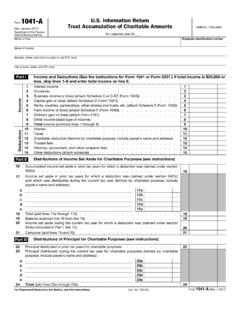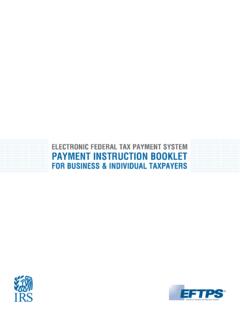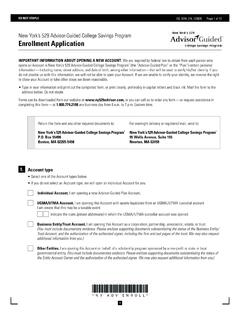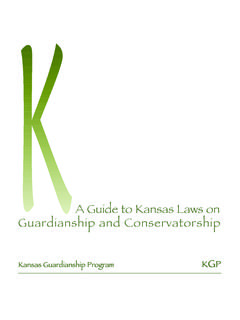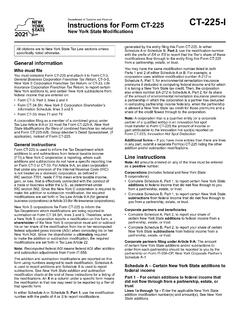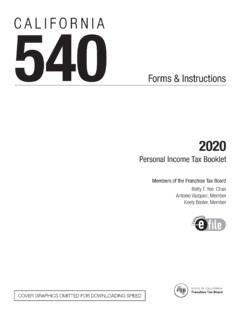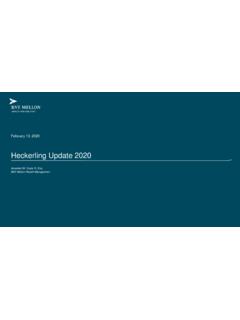Transcription of 2021 Instructions for Form 5227 - IRS tax forms
1 Userid: CPMS chema: instrxLeadpct: 100%Pt. size: Draft Ok to PrintAH XSL/XMLF ileid: .. ions/I5227/2018/A/XML/Cycle04/source(Ini t. & Date) _____Page 1 of 20 9:14 - 23-Jan-2019 The type and rule above prints on all proofs including departmental reproduction proofs. MUST be removed before for form 5227 Split-Interest trust information ReturnDepartment of the TreasuryInternal Revenue ServiceSection references are to the Internal Revenue Code unless otherwise DevelopmentsFor the latest information about developments related to form 5227 and its Instructions , such as legislation enacted after they were published, go to s NewQualified Business Income Deduction. For tax years beginning after 2017, individual taxpayers and some trusts and estates may be entitled to a deduction of up to 20% of their qualified business income (QBI) from a trade or business, including income from a pass-through entity, but not from a C corporation, plus 20% of qualified real estate investment trust (REIT) dividends and qualified publicly traded partnership (PTP) income.
2 The deduction is subject to multiple limitations, such as the type of trade or business, the taxpayer s taxable income, the amount of W-2 wages paid by the trade or business, and the unadjusted basis immediately after acquisition (UBIA) of qualified property held by the trade or business. The deduction can be taken in addition to the standard or itemized deductions. For more information , see section 199A, regulation sections through -6, Revenue Procedure 2019-11, Notice 2019-07, and Publication 't include social security numbers on publicly disclosed forms . With the exception of the items described below, form 5227 and its attachments are subject to public disclosure. Items not subject to disclosure include Schedule A (and any related early termination agreement); Schedule K-1; any K-1 continuation pages and transmittals; the trust agreement; trust amendments; form 926, return by a Transferor of Property to a Foreign Corporation; form 8582, Passive Activity Loss Limitations; form 8621, information return by a Shareholder of a Passive Foreign Investment Company or Qualified Electing Fund.
3 And any attachment that references contributor or donor InstructionsPurpose of FormUse form 5227 to: Report the financial activities of a split-interest trust , Provide certain information regarding charitable deductions and distributions of or from a split-interest trust , and Determine if the trust is treated (for Chapter 42 excise tax purposes) as a private foundation and subject to certain excise taxes under Chapter 5227 is open to public Schedule A of form 5227 to report: Accumulations of income for charitable remainder trusts, Distributions to non-charitable beneficiaries/recipients, and information about donors and assets contributed during the A of form 5227 isn't open for public Must FileAll charitable remainder trusts described in section 664 must file form 5227.
4 All pooled income funds described in section 642(c)(5) and all other trusts such as charitable lead trusts that meet the definition of a split-interest trust under section 4947(a)(2) must file form 5227 unless the Exception next A split-interest trust described below isn't required to file form 5227. The split-interest trust was created before May 27, 1969, and All transfers of corpus to the trust occurred before May 27, 1969, or As to each and every transfer of corpus to the trust made after May 26, 1969, no deduction was allowed under any of the sections listed in section 4947(a)(2).If a split-interest trust created before May 27, 1969, receives a contribution to corpus after May 26, 1969, for which a deduction is allowed under any of the sections listed in section 4947(a)(2), the trust will cease to qualify for the exception described above.
5 In that case, the split-interest trust must file form 5227 for the year when the transfer to corpus occurs and each subsequent year, the same as any split-interest trust created after May 26, Regulations section (a)(6) references form 1041-B, Charitable Remainder trust . form 5227 replaces form 1041-B. Regulations section references form 1041-A, information return trust accumulation of Charitable Amounts. form 5227 replaces form 1041-A for split-interest 2006, a split-interest trust no longer files form 1041-A for any Parts To CompleteThe term split-interest trust refers to trusts of various types. See the Definitions section of these Instructions below. Certain parts of form 5227 apply exclusively to a particular type of split-interest trust (such as a charitable remainder trust , also referred to as a section 664 trust ).
6 Parts or lines that apply exclusively to a particular type of split-interest trust are identified in these Instructions and on form 5227 with a parenthetical identifying the type of trust to which the part or line applies. Parts or lines that aren't indicated as applying to a particular type of split-interest trust should be completed by every type of split-interest trust with one exception. Parts VI-A and VI-B aren't completed by a charitable remainder or charitable lead trust whose charitable interests involve only war veterans' posts or cemeteries (as described in sections 170(c)(3) and 170(c)(5)).Jan 23, 2019 Cat. No. 13228 EPage 2 of 20 Fileid: .. ions/I5227/2018/A/XML/Cycle04/source9:14 - 23-Jan-2019 The type and rule above prints on all proofs including departmental reproduction proofs.
7 MUST be removed before trust . A split-interest trust is a trust that: Is not exempt from tax under section 501(a); Has some unexpired interests that are devoted to purposes other than religious, charitable, or similar purposes described in section 170(c)(2)(B); and Has amounts transferred in trust after May 26, 1969, for which a deduction was allowed under one of the sections listed in section 4947(a)(2).A split-interest trust is subject to many of the same requirements and restrictions that are imposed on private most common forms of a split-interest trust include the following:Charitable lead trust . This is a split-interest trust that annually pays a fixed annuity or unitrust amount to a charitable organization for the lead period specified in the trust instrument.
8 The lead period may be a term of years or it may be a period determined by the lifetime of one or more individuals, as described in Regulations sections (c), (e)(2)(vi) and (vii), and (c)-3(c)(2)(vi) and (vii). The donor to the trust will have been allowed a deduction under one of the sections listed in section 4947(a)(2). At the end of the lead period, annual payments to the charitable organization cease, and the remaining corpus becomes payable, outright or in trust , to a noncharitable (private) remainder annuity trust (CRAT). This is a split-interest trust described in section 664(d)(1). It pays a fixed dollar (annuity) amount, at least annually, to one or more recipients, at least one of which isn't a charitable organization.
9 The annuity amount must be at least 5%, but cannot exceed 50%, of the initial net fair market value (FMV) of all property contributed to corpus, subject to the further requirement that the remainder interest in the trust (measured at the time property is transferred to the trust ) must have a value of at least 10% of the FMV of the initial trust corpus. Payments to the recipient continue for a period of years. The period, if stated as a specific number, cannot exceed 20 years. The period can also be determined by the lifespan of one or more recipients. Whether the period is a fixed number of years, or is measured by an individual s lifespan, the value of the remainder interest must be at least 10% of the FMV of the property transferred to the trust (as explained above).
10 Upon termination of the recipient s entitlement to the annuity amount, the remainder interest is transferred to, or is used by, a charitable organization described in section 170(c), or qualified employer securities are transferred to an employee stock ownership remainder unitrust (CRUT). This is a split-interest trust described in section 664(d)(2). It is similar in many respects to a CRAT except that the amount payable to the recipient annually (the unitrust amount) is a fixed percentage (not less than 5% but not more than 50%) of the net FMV of the trust s assets, subject further to the requirement described above that the remainder interest must have a value of at least 10% of the value of the initial trust corpus, determined at the time property is transferred to the trust .










